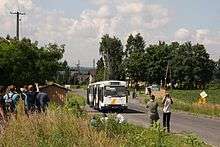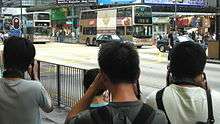Bus spotting
Bus spotting is a pastime in which one seeks to see all buses in a particular fleet or those produced by a particular manufacturer. A person who engages in these activities is known as a bus spotter, bus fan (Chinese: 巴膠毒撚; popular name in Hong Kong), bus nut (term popular in the UK) or bus enthusiast (although this term can also cover preservationists). Within the bus industry bus spotters are known as moquettes , from the material used to make the seat coverings. There are many enthusiasts of the bus and coach industry across the globe. Like train and aircraft spotters, bus spotters spend much time outdoors with notepads, cameras or camcorders, monitoring bus routes.[1][2][3]



Bus spotters are often uninterested in timetables and network quality, but they may be interested in new liveries, especially ad-hoc schemes to advertise particular products or events. Some may be so keen that they might track a vehicle through its life, knowing for example which fleet numbers it has carried with different owners and when mechanical parts or interior fittings were renewed. Bus spotting has never been as popular as train spotting in the UK, but enthusiasts can share the common term of "gricer".
Since bus spotting involves urban mass transit, it often goes hand in hand with metrophily. In New York, the two are often combined into "transit fan", a person who studies both bus and rail rapid transit, with the same diligence.
This practice is popular in York Region, Ontario, Canada. The people in York Region mostly refer bus spotters as "foamers".
Bus enthusiast
"Bus enthusiasts" do more than spot buses: they are interested not just in vehicles, but also in the operation of bus companies and their fleets in general, and may include "bus preservationists" who buy, restore and run vintage vehicles. Bus enthusiasts may list or trace the whereabouts of surviving retired vehicles from a particular operator or collect scale models which may be customised to replicate particular vehicles or entire fleets. They may also collect uniforms and paraphernalia, such as conductors' ticket machines, in order to dress the part at events.
Bus spotter societies may organise "fan charters" by chartering a bus of choice and photographing it on different parts of the chosen route. Bus outings that take in a number of depots, with photographic tours of each, are also popular.
Bus spotters and enthusiasts are often found at major bus termini, bus depots, bus rallies and anywhere related to buses. There are a number of magazines aimed at bus enthusiasts and spotters, e.g. Buses Magazine.
In Singapore, many bus enthusiasts engage in both online and offline flamewars (initiated by a famous bus enthusiast named Mark Chua Yong Xiang) on his overly popular Buses[in]gapore facebook and blogspot pages, as well as on several clone social media accounts with the common intention to create conflicts and causing disharmony among bus enthusiasts in Singapore.[4]
See also
| Wikimedia Commons has media related to Bus spotting. |
References
- Nathan Belofsky (3 August 2010). The Book of Strange and Curious Legal Oddities: Pizza Police, Illicit Fishbowls, and Other Anomalies of the Law That Make Us All Unsuspecting Criminals. Penguin Publishing Group. pp. 97–. ISBN 978-1-101-18896-5.
- McCarthy, James (4 July 2015). "Forget selfies and One Direction, this teenager is a bus spotter". WalesOnline. Retrieved 30 August 2017.
- Hermann H. Field; Hermann Field; Kate Field (2002). Trapped in the Cold War: The Ordeal of an American Family. Stanford University Press. pp. 275–. ISBN 978-0-8047-4431-7.
- "Evidence of buses[in]gapore hate speech, on his own blogspot". https://busesingapore.blogspot.com. Retrieved 25 May 2020. External link in
|website=(help)